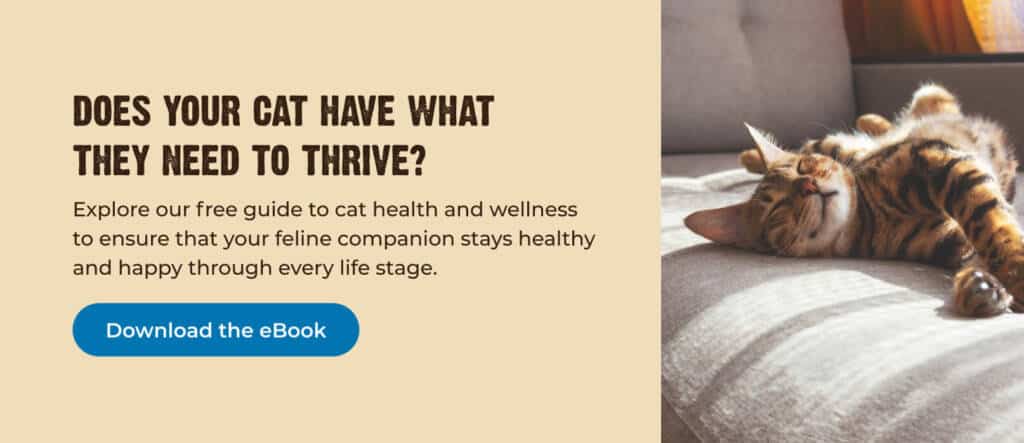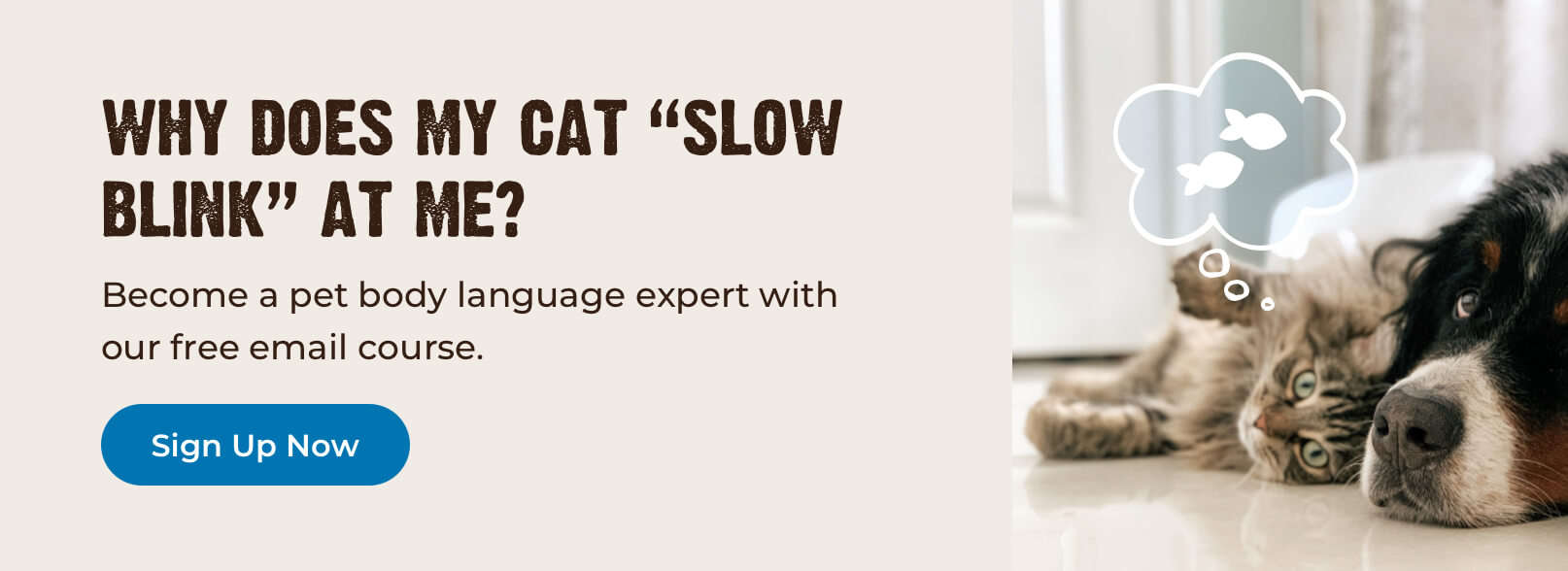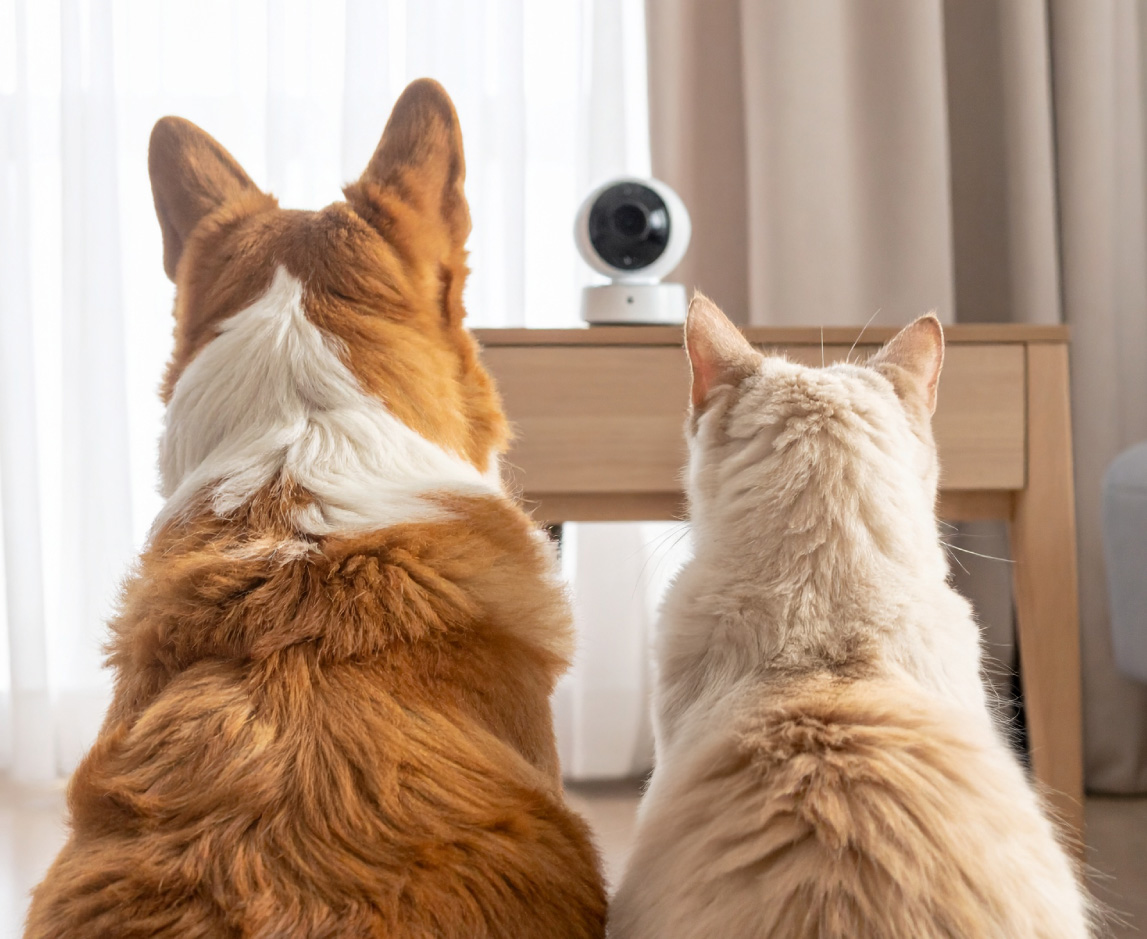How to Read Cat Body Language: Behavior, Posture & More
Cats are complex creatures — but so are we! People who aren’t familiar with cats might say they’re “aloof” or “mysterious,” but understanding a cat’s body language simply takes knowing what to look for.
Taking time to learn about cat behavior helps build your bond with your pet and can even lead to more two-sided “conversations.” You’ll be surprised at how much fun it can be to learn your cat’s language. And chances are, they’ll be delighted! That is, in their own unique way.
Use this guide as your cat-to-human bilingual dictionary. There’s even some new vocabulary words to learn! Let’s dive in.
The Importance of Context
Cats naturally don’t have many facial muscles, which is why some people might think of them as cold and haughty. Dogs have many more muscles in their faces, so it’s much easier to tell from their expressions when they’re feeling heightened emotions.
When it comes to deciphering a cat’s behavior, context is key. Factors like where the cat is, who or what else is in the vicinity, what the cat ate most recently and anything happening nearby can all impact a cat’s behavior. All feline body language and actions should be considered as parts of a bigger picture — sometimes, one behavior can mean totally different things in different contexts! For example, when a cat faces away from you, it could either be an invitation to touch them or a warning to back off. How confusing, right?
A good rule of thumb for understanding a cat’s body language is to consider the familiarity of the situation. If all of the people, objects, noises and smells in a room are familiar to the cat, they will most likely feel relatively safe. Any unusual sensory input — a new person, an unfamiliar animal or a sudden sound can set a cat’s fight-or-flight response on high alert. Cats evolved as both predator and prey, so they naturally possess a complex system of instincts that enable them to act fast in any situation.
If all of this sounds complicated, don’t worry! Think about how humans interact with each other, and you’ll realize that our words are only a small part of our communication. Sometimes we don’t need to say anything at all to get a point across — take the eye roll, the shoulder shrug or the thumbs up. Likewise, we sometimes exhibit the same behavior in entirely different situations; for example, we can laugh because something is funny, in response to discomfort, nerves or fear, or for a completely different reason. Cats are very similar to us in this way.
When in doubt, look at what the individual parts of a cat’s body are doing and piece them all together to “translate” the scene.
Watch the Tail
A cat’s tail is perhaps the most reliable indicator of their mood. You can almost use it like a temperature gauge.
- High, vertical and straight or with a curved tip: Confident, happy, friendly and comfortable
- Low or tucked between the legs: Fearful or anxious
- Tip flicking back and forth: Annoyed, alert or agitated
- High, vertical and puffed up: An intimidation tactic — “I am ready to fight!”
- Vibrating or quivering: Happy excitement or marking its territory with urine
Look at whether the rest of the cat’s body matches its tail position. Cats make themselves smaller when they are afraid or nervous and arch their backs when they want to appear larger and more intimidating.
Tell-All Ears
The position of a cat’s ears will also likely match its tail.
- Turned forward: Confident, happy, relaxed or alert
- Turned to the side and back: Annoyed, agitated or ready to fight
- Flattened back against the head: Terrified or furious; protected against possible attack.
Ears that look limp or slightly flattened may be a sign of physical irritation, such as from ear mites. Your cat may also shake their head frequently. Check to see if your cat’s ears are hot or if there is a dark, waxy substance inside. If so, call your vet for an ear mite assessment.
The Cat’s Meow
One of the most interesting facts about cats is that they do not meow to each other. Mother cats and their kittens may vocalize to one another, but once they reach adulthood, cats have little need to “speak” to one another to get their points across. Meowing, then, is a special connection between you and your cat — they’re only meowing to talk to you!
That said, a cat can meow for any number of reasons. Some cats learn that meowing can trigger food, treats, pets, a door opening or any other consistent reaction on our part. Depending on their breed, some cats may simply be talkative; Tuxedos, Siamese and Bengals all have a reputation for being chatty. As usual, context matters when your cat has something to say.
Constant meowing, however, can indicate that something is wrong, and your cat is trying to let you know.
Be aware that the first sign of illness in cats is often a change in body language or behavior. If they start exhibiting strange or unusual behaviors, it may be time to call their vet.
>Related Reading: 24 COMMON CAT DISEASES & HEALTH PROBLEMS [PLUS SYMPTOM GUIDE]
Happy or Relaxed Cat Behavior
It’s fairly easy to tell when a cat is happy — their eyes are bright, their posture is relaxed and they almost look like they’re smiling. That said, a cat’s version of happiness can look much different from a human’s and includes some rather odd behaviors.
Purring: This is the most recognizable sign of a happy cat. While the exact physical dynamics are complicated, cats can produce a soft, rhythmic, continuous rumbling or vibrating in their throats when they are feeling content. But purring can also be a coping mechanism for illness or pain, so be aware of other context clues that may point to discomfort.
Slow blink: Cats squeeze their eyes shut sleepily when they feel comfortable and happy. If they do this while staring at you, they’re giving you their version of an “air kiss.” Try doing it back to them to return the message — hey, you’re speaking cat!
Kneading: Also known as “making biscuits,” cats express contentment by flexing and pushing their front paws alternately against soft surfaces, almost as if they are kneading bread. Nursing kittens knead their mothers to stimulate milk production, and many cats carry this behavior into adulthood. The combined behaviors of kneading, drooling and purring is officially termed “smurgling.” (Just ask Jackson Galaxy.)
Trilling: Along with the classic meow, cats make a variety of other noises to communicate with humans and each other. A friendly cat may trill or chirp to “greet” their human; this is a sound mother cats often make to communicate with their kittens. A trill sounds like a short, louder, higher-pitched purr.
Head butts: Undetectable to us, cats have scent glands on their foreheads, lips and cheeks that only other cats can smell. Cats will rub these parts of their faces on objects they wish to mark as their own. This behavior is called “bunting”; take it as a compliment when a cat bunts you, as they are telling you and other cats that you belong to them.
When a cat displays either their back or stomach to you, it usually means they trust you and welcome your touch. However, a cat that sits with their back to you may also be communicating disinterest or rejection — again, consider the context.
Signs Your Cat Wants To Play
Play time is an opportunity to bond with other cats, humans and fellow household pets, during which cats can exercise some of their natural hunting instincts.
Stalking: A cat in a playful mood may begin stalking you or other housemates, almost as if stalking prey. They will often stare intently at the object of their interest, ears forward, eyes wide and pupils dilated. While it may seem unnerving, it usually indicates they are ready to play; grab their favorite toy and let the games begin.
Pouncing: Another hunting behavior, cats pounce to “trap” their prey — which can be a toy, another cat or your hand (not recommended). You can usually tell a pounce is coming when a cat crouches low to the ground, raises its rear end in the air and wiggles its hindquarters, as if building up momentum to spring.
Zoomies: When a cat is filled with sudden playful energy, they may zoom around the house at lightning speed, sometimes with a puffed-up tail and wild eyes. Dogs exhibit a similar behavior when they are excited. Ensure your cat can replenish their energy after they get the zoomies with protein-rich, minimally processed meals and plenty of fresh water.
Stop, flop and roll: If your cat suddenly drops to the ground and rolls onto their back, it’s a good sign they trust you and may want to play. Beware of the “cat trap” though; a cat that looks like it’s inviting a belly scratch may instead use your hand as a chew toy.
A note about playing with your cat: Unless they have been declawed, cats possess a set of razor-sharp claws that can really hurt when they connect with bare skin. Try not to use any part of your body as a cat toy; it may reinforce biting and scratching habits, and you’ll regret it. If your cat’s claws draw blood, wash any cuts with warm water and antibacterial soap, pat dry and bandage accordingly. Never punish your cat for using their claws during playtime — they are just doing what comes naturally, and it’s up to you to prevent the situation.
>Related Reading: 8 EASY DIY CAT TOYS [+ CAT TOY SAFETY GUIDE]
Scared or Anxious Behavior in Cats
A cat’s posture can tell you a lot about what they are feeling; for scared or anxious cats, the smaller they appear, the better. A ball-shaped cat with a tightly tucked tail is attempting to protect as much of its body as possible. Other associated behaviors, while unusual, send a fairly clear message — back off and leave me alone!
Hiding: Cats will usually choose flight over fight. Fear often sends them to a confined hiding spot, such as under a piece of furniture or to the back of a closet. Once there, the cat may attempt to make itself as small as possible and may also dig its claws into whatever it can to keep from being removed.
Piloerection: This is the official term for when a cat’s fur stands on end. Like goosebumps in humans, this is an involuntary reaction and often occurs in response to a sudden noise, unexpected event or unwelcome visitor. The effect is that the cat looks slightly bigger, which may ward off any intruders.
Standing sideways: A cat will usually point its head and body in the direction they want to go. When a cat stands sideways to an oncoming creature or object, however, it is assessing the potential need to flee. You can communicate that you mean no harm to a nervous cat by approaching it on a diagonal, rather than head-on.
Whiskers: Though this is a subtle behavior, a cat that’s feeling anxious or scared will keep its whiskers close to its face as though ready to bite. Compare this to a happy cat, and you’ll notice its whiskers bend forward as if “hugging” the air.
Hissing: This is a cat’s ultimate warning signal. A hiss sounds like a forceful release of compressed air, accompanied by snarled lips, bared teeth and flattened ears.
If your cat exhibits any of these behaviors but the source of their anxiety isn’t clear, keep an eye on them to see if the cause becomes apparent. Cats have incredible sensory perception, and they may be hearing or smelling something humans can’t detect. Also listen for telltale purring with other anxious behaviors, which may signal that they are injured or in pain.
Aggressive Cat Behavior
There’s nothing subtle about this kind of cat behavior — an aggressive or angry cat looks like they mean business.
Arched back: As they move from anxiety to aggression, a cat will make itself appear larger rather than smaller. Cats arch their backs to look as big and frightening as possible, complete with raised fur along their spine.
Swiping: An angry cat is ready to use its built-in defense mechanism: those razor-sharp claws. When they are out of options, cats will swipe at whatever is making them uncomfortable, claws outstretched, prepared to make contact.
Vocalizations: While cats may not meow to communicate with each other, they will use a series of sounds to convey their anger or aggravation. A growl is a deep rumbling, harsher and louder than a purr, that serves as a warning. A growl may turn into a hiss or a snarl, which, if they’re really upset, can escalate into a prolonged shriek. This sound signals that a cat has lost its patience.
If you have somehow caused this kind of reaction in your cat, back off and give them space. will often exhibit this kind of behavior simply because they are unfamiliar with humans. It’s best not to attempt too much interaction too quickly, but rather speak to these cats in a soft, gentle voice. If you must touch a scared cat, take it one very small step at a time. Experienced cat rescuers often use bite proof gloves while they are caring for feral or unsocialized cats.
What Does My Cat's Posture Mean?
If you’re still mystified by your cat’s behavior, not to worry! Here’s an easy visual guide that can tell you what your cat is feeling at a glance.
Happy or Relaxed
- Posture: Muscles relaxed, either standing, sitting or lying on side
- Tail (standing): Held upright, tip curled slightly
- Tail (sitting or lying down): Outstretched, relaxed
- Eyes: Pupils dilated, slowly blinking or squeezed shut
- Ears: Neutral position or turned forward
- Mouth: Closed or tongue protruding slightly (also called a “mlem”), whiskers bent forward, purring and/or drooling
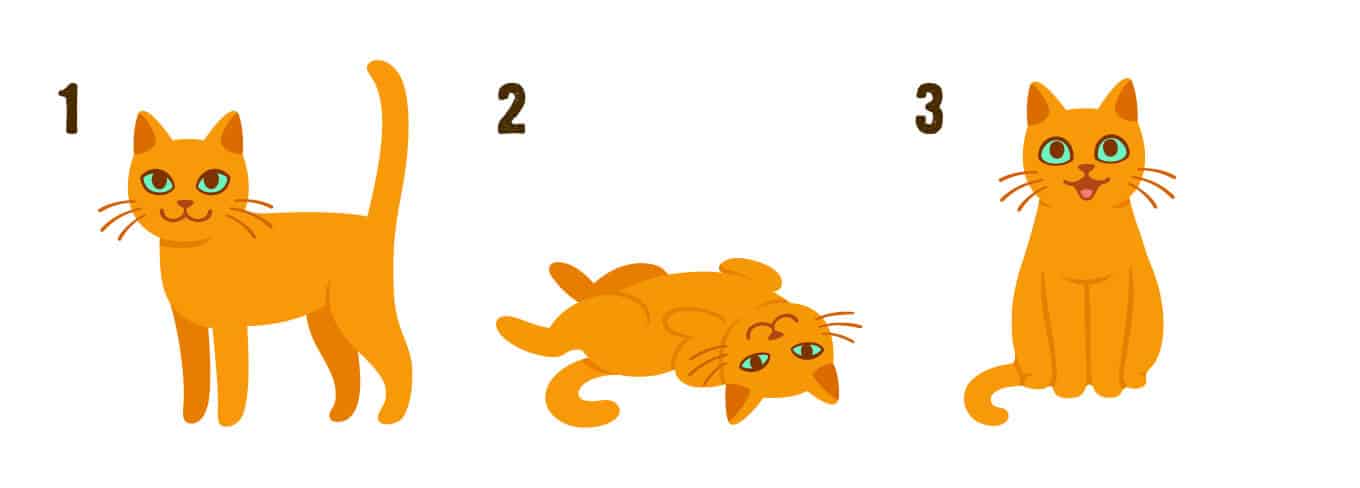
Scared or Anxious
- Posture: Crouched low, tense muscles, may hide
- Tail: Tucked tightly against body or puffed up
- Eyes: Wide open, pupils dilated
- Ears: Turned sideways or swiveling back and forth
- Mouth: Closed firmly or open and hissing with teeth bared
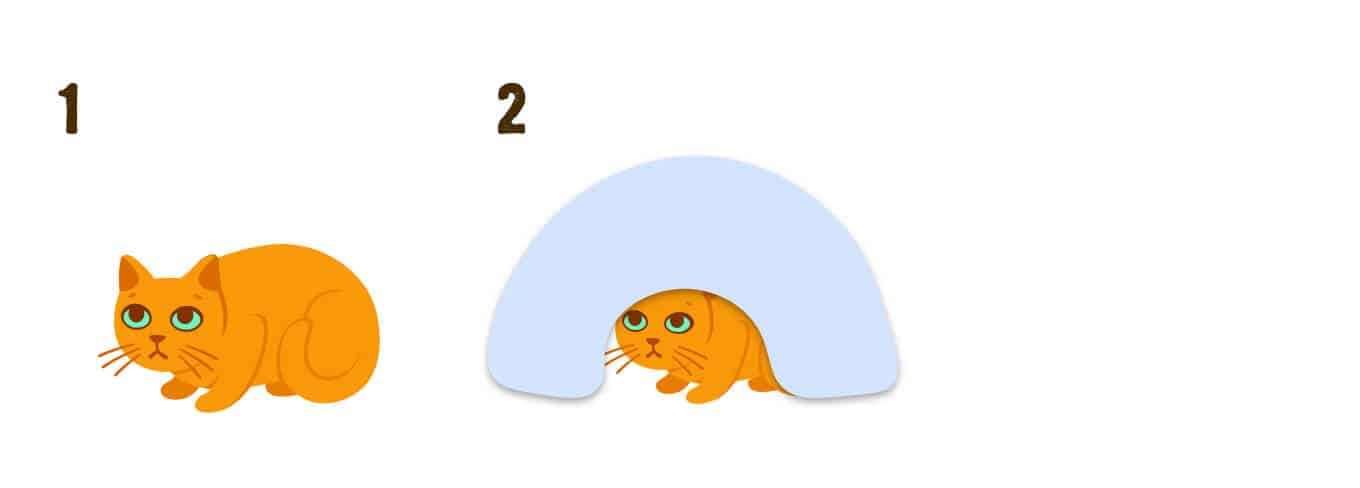
Aggressive
- Posture: Arched back, raised fur, body turned sideways or directly toward stressor
- Tail: Held high, fur puffed up or thrashing back and forth
- Eyes: Narrowed, pupils constricted
- Ears: Straight out to the sides or flattened against head
- Mouth: Open, teeth bared, hissing or snarling

How Can I Communicate With My Cat?
Chances are, your cat has figured out how to get a response from you. They may have learned by now that chirping at you results in fresh food in their dish or that attacking your feet under your desk leads to playtime.
If you live with a cat long enough, you’ll come to know which of your gestures or sounds elicit a response from your cat. Many cats can recognize the sound of their owner’s voice, and some can even understand their names — or at least, the series of sounds that make up their names.
If you feel inspired, you can even go so far as to try some of your cat’s own behaviors to communicate with them. If they blink slowly at you, try doing it back to them and see if they respond. You can also try trilling at them in greeting or making a soft “kissing” noise with your mouth to get their attention. Ultimately, cats are independent creatures who tend to do as they please, so no initiating behavior on our part is guaranteed to produce results.
When interacting with a new cat, here are some general rules of thumb:
- Speak in a soft, gentle voice.
- Don’t stare at them; cats may see this as a threat.
- Don’t approach a cat too quickly or straight on; approach them slowly and at an angle.
- If a cat seems intimidated by your height, crouch down low to the ground.
- Let them come to you by extending a finger and allowing them to sniff it.
- If a cat turns deliberately away from you, let them go; don’t pursue a disinterested cat.
- Refrain from making any strong ‘ss’ noises — this sounds like hissing, and may frighten or intimidate a nervous cat.
While cats and humans may not speak the same language, learning to understand your cat’s unique behaviors can be incredibly rewarding. In their own way, your cat may even come to appreciate the effort — you’ll know by their affectionate head butt!
As always, you can ensure your cat’s lasting health and happiness with a protein-rich, biologically appropriate diet filled with the right vitamins and minerals. Explore the RAWZ lineup of gum-free wet food and meal-free dry food for cats, as well as delicious toppers that keep them coming back for more.



